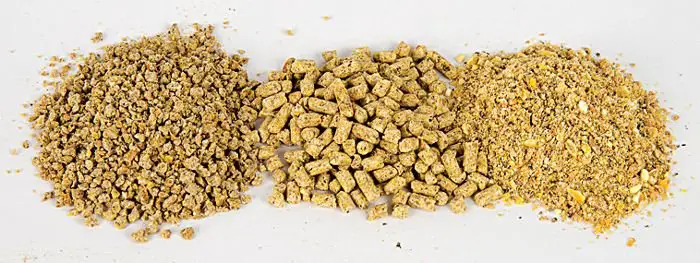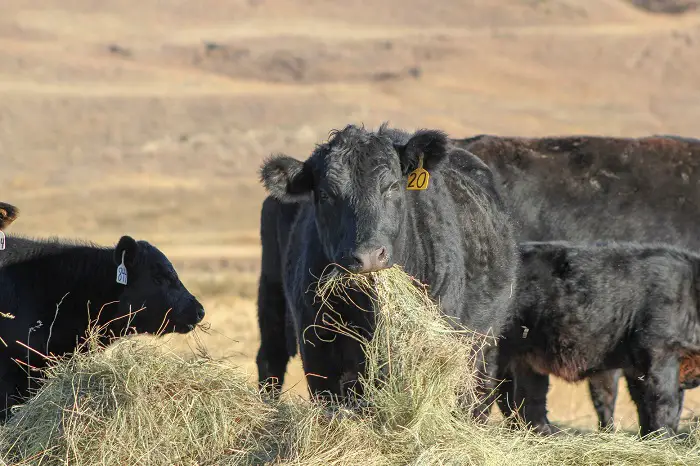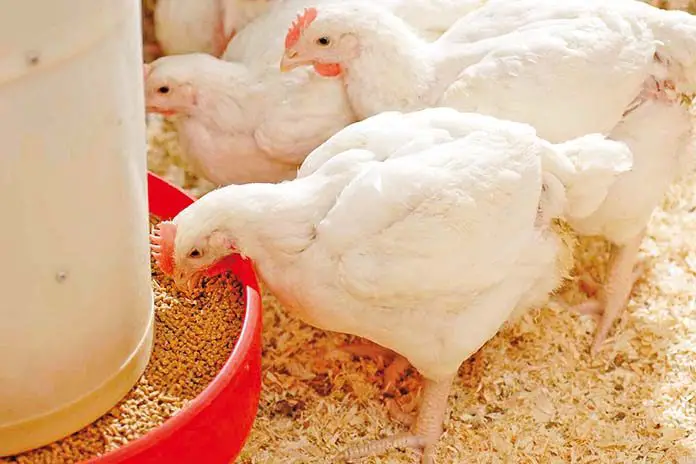There are various types of cattle feed available and their use is highly dependent on the goals of the farmer. These goals can be meat or milk production or maintenance. Cattle feed come in three main types which are:
- Roughages
- Concentrates
- Straight mixed rations
Contents
Roughages
These are fibrous feeds that are essential in the feeding of cattle, pasture, veld grazing, and crop residues are the most common sources of roughage.
Silages
Silage is one of the best roughage feeds that can be fed to cattle. The process of making silage involves harvesting high-quality fodder mostly from cereals during times of excess or fodder crops grown, specifically for making silage. Ryegrass, maize, and sorghum make good silage when cut after seeding. To make silage chop the fodder at about 30% of dry matter, and compact the chopped material in silos or pits to exclude air. The pit or silo is then sealed off to allow fermentation in the absence of oxygen which can cause the silage to rot. Feed the silage during the dry season.
Hay
Hay is commonly made from cut immature grasses cured in the sun, but can also be made from legumes like alfalfa or lucerne or a combination of both. Specific grass or plant species or varieties are allowed to grow out on the pasture and then cut whilst green and sun-dried. Hay acts as a long-term store of cattle feed for periods when supply is low and can either be stored as bales or loose hay.
Straw, Stover and Chaff
A clear distinction needs to be made on the difference between hay and straw, straw is mature grass or crop whose seeds have been harvested. The remaining stems and leaves are called straw or stover examples are wheat straw, maize and lucerne stover. Chaff from the cleaning of grains can also be fed to cattle as a high roughage source
Pastures and natural veld
The most cost-effective way to feed cattle is to utilize pastures and/or natural veld as cattle can essentially live off grass, converting grass efficiently to meat and milk. These are usually pieces of land where grasses, legumes, and herbs are grown to graze the cattle. These crops/grasses can be grown singly or as a combination with legumes like clovers, giving a richer pasture. Farmers with pastures have better control of feed availability for their cattle by than those utilizing natural veld and can control the grazing in the pastures using electronic strip grazers. On natural veld, the farmer needs to be fully aware of the carrying capacity of the land, which is the number of cattle that can be grazed per hectare of land. This is determined mostly by the available grass species on the veld as some grasses are not as productive as others. Cattle also have their likes and dislikes when it comes to grass and forages hence the farmer needs to be aware and promote the growth of the most desirable species.
By-Products
Most by-products used for cattle feeding are mostly from grain harvesting and processing which include maize bran, wheat bran, rice bran, wheat pollard, and cottonseed hulls. However, cattle can be fed a wide variety of by-products from different industries like brewing and sugar processing. Good examples are molasses and bagasse from sugar refining and brewers’ wastes or grains also called distillers dried grains from alcohol production. By-products like chicken manure can also be used to supply protein in cattle feeding. Because of the wide variety of by-products available they fall into their own subcategory of feeds for cattle. The use of by-products can give the farmer good savings in overall feed cost if the chosen by-product supplies the required nutrients at a good price.
Concentrates
Concentrates are commercially formulated and produced cattle diets rich in protein or energy or both but low in roughages. These are mixed with other ingredients mentioned above like hay, molasses, or by-products as per the manufacturer’s recommendations to come up with a balanced cattle feed. Crops like alfalfa and maize can however be classified as concentrates due to their high protein and energy content respectively and have to be fed in conjunction with other ingredients. This cattle feed type is designed to meet different objectives but mostly to cover any gaps in nutrient supply from the pasture, veld or forage being supplied to the cattle in the most profitable way possible in terms of feed cost and productivity of the herd.
Straight feeds
These type of cattle feeds are specially formulated and completely balanced, ready ready-to-feed with no additional ingredients required. Complete feeds are mostly used where animals are raised in confinement and performance is of the utmost importance. These cattle feeds can also be referred as to complete diets or total mixed rations. With the advent of highly mechanized farms, some farms can mix their own cattle feed to meet their performance objectives. Commercially produced feeds will come with a feeding guide detailing the class of animal and amounts of feed to be fed. Total mixed rations are common in dairy cattle feeding and beef cattle fattening operations across the world.
Supplementary Feeds
This is not a subclass of cattle feed but a definition of how most of the above feeds are utilized in the feeding of cattle. Supplementary cattle feeds are designed to add or supply deficient nutrients from the primary diet. These feeds are often used to supplement cattle that survive on grazing. With the seasonality of weather patterns, the grass quality also tends to change with the season hence the need to balance out the deficient nutrients. Supplementary feeds are thus normally classified into summer and winter supplementary feeds. Common winter supplements will be protein supplements like protein licks and blocks with summer supplementation mostly in the form of mineral supplementation. However, this will vary with location and the ability of the farm to supply the required nutrients at different times, at other times energy or fibre supplements can also be utilized.
Cattle being ruminants, the type of feed that is fed to them has to have the ability to support the rumen microbes which are the main agents in the normal function of the cow’s digestive system. Hence the right mix of mostly fibre, protein, and energy is crucial to get the best performance out of the animals, sources of these are diverse and choice will be determined by availability, quality, and cost.




